1.2 Science and Technology to Create a New Society
1.2.4 Science and Technology for the People and the Human Resources to Support Them
Summary
In order to vigorously address an aging society with fewer children through application of science and technology in the future, an important basis would be that each member of the public has basic knowledge and ability regarding science and technology. At present, however, the level of Japanese people's interest in and understanding of science and technology is low compared to other countries in the world. Therefore, there is a need to foster a sense of empathy and confidence among the people for science and technology by promoting active moves by researchers and other people in the science and technology sector toward the general public for interactive communications, as well as efforts by schools at the elementary and secondary education levels.
Furthermore, the activities of people working in science and technology will become more and more diverse and important in the future. Since the labor population is expected to decline due to an aging society with fewer children, it is necessary to develop and ensure the quality and quantity of diverse science and technology-related human resources that meet the needs of society, and to create an environment in which each one of them can fully demonstrate his or her abilities regardless of age, gender, or nationality.
1.2.4.1 Science and Technology for the Sake of the People
(1) Understanding and interest of individuals toward science and technology
● Necessity of understanding and interest in science and technology
Science and technology continues to become more closely related with our daily lives, but in recent years there is a decline in interest in science and technology among the people in Japan, particularly among the young (Figure 1-2-52).
However, in the midst of a global shift to knowledge-based society, it is crucial for people to have an understanding of and interest in science and technology in order to actively cope with an aging society with fewer children through the creation of intellectual and cultural value, and the resolution of social and economic problems with science and technology, as shown in the previous section.
First, when science and technology returns results to society, it is necessary to have the appropriate foundation for the use and adequate understanding among the public receiving the results, so that the science and technology results are applied effectively and efficiently. Familiarity with the scientific concepts and basic scientific principles is useful in daily life, not only for the introduction and use of new science and technology devices.
Second, it is difficult to achieve a society with science and technology closely related to everyday life and work without the support of the people living in the society. A measurable percentage of people have some anxiety about the development of science and technology (Figure 1-2-53). It is true that the impact of science and technology on our society has had negative aspects such as environmental problems, and involves challenges including bioethical questions. It is also natural for people to be uneasy as science and technology becomes more and more advanced, exceeding their own ability to understand. Therefore, for the future promotion of science and technology it is necessary to work to obtain the empathy and confidence of the public, and to establish the viewpoint of science and technology for society, and science and technology for the people. There is a need for citizens to deepen their understanding of science and technology and to participate in decision-making regarding the operation and role of science and technology.
● Improving science and technology literacy
It is important for individual citizens to have a basic understanding and ability in science and technology (science and technology literacy) for sufficiently enjoying the results of science and technology, considering desirable implementations of science and technology in society with interest, and forming their own opinions.
Methods likely to be effective in improving the science and technology literacy of citizens include presenting easy-to-understand, specific information on knowledge, skills and viewpoints on the science and technology that should be familiar to adults.
The Third Science and Technology Basic Plan sets forth that such ideal science and technology literacy should be defined and widely disseminated.
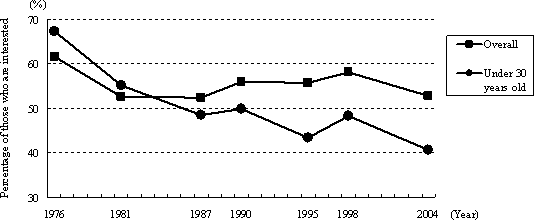
Figure 1-2-52 Interest in science and technology news and topics
Note:
Percentage of people who responded either [Interested] or
[Somewhat interested]
Source:
Cabinet Office "Public Opinion Poll on Science and
Technology and Society"
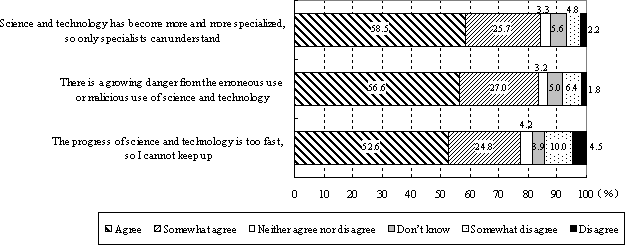
Figure 1-2-53 Problems accompanying the development of science and technology
Source:
Cabinet Office "Public Opinion Poll on Science and
Technology and Society" (February 2004)
● Status of science and technology literacy and interest in Japan
It is important that citizens have an appropriate level of science and technology literacy in order to move forward into a new society through science and technology. At present, however, the understanding of adults in Japan regarding the basic concepts of science and technology is low in comparison to international levels. (Figure 1-2-54) Of course, science and technology literacy is not just about understanding these kinds of basic concepts, but it does indicate that there are challenges to be tackled for improving science and technology literacy.
Figure 1-2-54 shows the degree of understanding by adults in Japan and various countries in Europe and America regarding the basic concepts of science and technology, along with the academic ability of children in science and math. This figure indicates that, in general, countries in which the science and math abilities of the children are high also have a high level of understanding among adults, while low math and science abilities in children are associated with low levels of adult understanding. In Japan, however, situation is quite unique, as the academic abilities of the children are at the highest international levels, while the degree of understanding of science and technology among adults is in the bottom level.
From this figure, comparing the countries with equivalent levels of academic abilities in children, the 13 countries in which adult interest in science and technology is low, including Japan, had a tendency to have lower levels of adult understanding than the 12 countries in which the interest is high. This illustrates the relationship between degree of interest and level of understanding.
Figure 1-2-55 shows the degree of interest in science and technology among people in Japan from elementary school to adulthood, broken down by grade level/age. For the elementary school through high school students, the results are from surveys asking whether they like or dislike studying science and math. For subjects over the age of 18, the results are from polls on science and technology needs and topics of interest. Therefore, the results cannot be compared on an equal basis, but some patterns can be observed. Among students, the percentage of children who like science and math/arithmetic decreases as grade level increases, dropping to 37%-38% among 3rd year high school students, and the interest in science and technology among 18-19 year olds is 36%, roughly the same. From their twenties, however, there is a gradual increase in the percentage of those with an interest in science and technology needs, reaching a peak among those in their 50s, and then tending to decline.
In Japan, the academic ability of children in science and math is at the highest levels internationally. In comparison, the interest in science and technology (study of math and science) drops as they progress to higher academic levels. This does not change after reaching adulthood, and the degree of understanding of science and technology among adult- s is far below international levels.
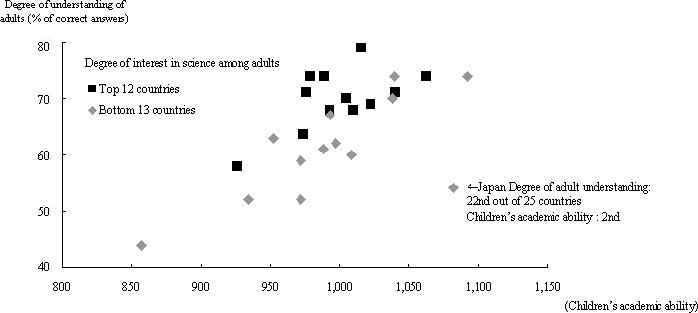
Figure 1-2-54 Degree of understanding of science and technology among adults and academic ability of children (25 countries, including Japan)
Notes 1:
The degree of understanding of basic concepts of science
and technology among adults is indicated by the average percentage of correct
answers to the same 13 questions in each country.
Notes 2:
The academic ability of children is the combined average
score on science literacy and math literacy form PISA 2003 surveys by OECD.
Notes 3:
The degree of interest in science among adults is the
percentage of those who responded that they were "very interested"
or "fairly interested" in news reports on new scientific discoveries.
Source:
National Institute of Science and Technology Policy, Ministry
of Education, Culture, Sports, Science and Technology "Survey on the awareness
about science and technology" (NISTEP REPORT No. 72, March 2001)
US
National Science Foundation (NSF) "Science and Engineering Indicators
2002"
European Commission "Special Eurobarometer-Europeans,
Science and Technology"
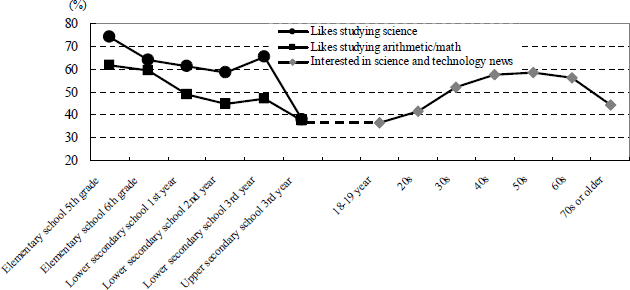
Figure 1-2-55 Interest in science and technology by grade level and age
Note:
For the 5th grade of elementary school through the 3rd year
of upper secondary school, percentage of students responding "yes"
or "I guess so" when asked if they like studying each subject. For
those 18 years and older, the percentage of those responding "interested"
or "somewhat interested" regarding their reaction to topics and news
about science and technology.
Source:
National Institute of Science and Technology Policy, Ministry
of Education, Culture, Sports, Science and Technology "2003 Research on
Curriculum for Primary and Lower Secondary Schools," and "2002 Research
on Curriculum for High Schools"
Cabinet Office "Public Opinion
Poll on Science & Technology and Society" (February 2004)
● Propagation of indifference
What causes the decline in interest among children? According to the results of a questionnaire on the things that affect whether they like or dislike science, more than 80% of students up through high school indicated school (teachers) and family (parents/guardians), making it clear that the adults around the children have a large influence (1-2-56).
Accordingly, in consideration of this and the points mentioned above, it seems likely that there is a self-perpetuating cycle of disinterest, as children with low interest become adults with low interest, and the low-interest adults influence the next generation of children to have low interest. In such a situation it is likely that the awareness and understanding of science and technology among adults would also be low.

Figure 1-2-56 Things that affect the like/dislike of science
Source:
Ministry of Education, Culture, Sports, Science and Technology
commissioned project "Report of Study on New Science and Technology Learning
Support Methods (theme 5)" (March 2003)
(2) Building empathy and confidence in science and technology
● Mechanisms to vitalize communications to connect science and technology and society
It is necessary to decrease the number of children and adults with no interest in science and technology, increase science and technology literacy, and invigorate two-way communications between science and technology and society.
There should be outreach programs through which researchers and engineers explain their research to the public in easy-to-understand ways, as well as hear the desires and anxieties of the public and reflect them in their activities.
The role of mediators to convey the current situation in ways that can be easily grasped, including the negative aspects as well as the fascination of science and technology, is increasingly important, including support of outreach activities between researchers/engineers and the public. In addition, there is a need to increase the opportunities for people to touch, experience and learn about science and technology at museums and science exhibition centers, and foster and ensure specialized personnel to be the workers responsible for these activities, volunteers, and science and technology journalists. It is also important to devise new ways to blend science and technology with traditional arts and crafts.
For children, the role of schools is especially important. Furthermore, there must be efforts to train and improve the quality of good teachers, and coordinate among schools, local universities, public research institutes, businesses and museums so that they can convey to children the importance and pleasure of learning science and math by providing more opportunities to speak directly with researchers and meet them face-to-face, and to understand empirical and problem-solving science and technology through observation, experimentation and training.
Through such a mechanism there is expected to be a greater familiarity between science and technology and the public, fostering a sense of confidence and empathy. If such a society can be built, this will lead to a larger pool of children who will be able to grow up and take over the activities and creativity of science and technology in the future.
In Japan, in accordance with the Third Basic Science and Technology Plan, there will be active support for the measures of these kinds of interested parties.
● Researcher/engineer ethics
Measures aimed at science and technology for the benefit of society are in progress through the efforts of interested parties. In recent years, there have been incidents related to the ethics of researchers, scientists and engineers, such as falsified experimental data, and cases of deceit and cost-cutting in the structural accounting of buildings, creating a large problem for society. Trust in science and technology and all those working in science and technology has been damaged by a few researchers and engineers. It is unfortunate that the actions of a minority have a negative impact on the development of science and technology, and it should not be allowed to occur.
To prevent such incidents, first, the system is founded on the self-regulation of researchers and scientists and it is necessary to establish behavior standards and codes of ethics, and to promote extensive ethical education. It is also probably effective to prepare a system, such as a procedure or organization to investigate and evaluate any suspicion of impropriety in research. In various countries overseas there are already efforts to develop such organizations (Table 1-2-57).
In Japan, in December 2005 Riken placed the emphasis on ethical compliance on the researcher's themselves, and established a practice of appropriate and rigorous handling as an organization in the event that a problem occurs. Behavior standards and basic guidelines for dealing with labs in the event that there is a suspicion of improper behavior have been established.
For Professional Engineers certified to have high-level, special application abilities related to science and technology, a revision of the Professional Engineers Law in 2000 stipulates a new responsibility to make efforts to ensure that there is no dam- age to public good, environmental preservation or public safety in the practice of their profession. In addition efforts are being made to improve the ethics of engineers, etc., including the inclusion of questions on propriety in the Professional Engineers Examination.
However, these measures are the only one's covering those in Japan as a whole. According to a survey in 2004 of academic societies registered with the Science Council of Japan about 3/4 of the societies responding indicated that they had no ethics plan established or investigated.
In February 2006 the Council for Science and Technology Policy decided the "Handling Misconducts in Research" to provide its opinions to the relevant ministries. It stated that there was a need to quickly deal with problems of misconducts in research, and requested that the researcher community, relevant ministries, as well as universities and research institutes take measures according to their respective positions based on the autonomy of those involved in research.
At present, the "Special Committee on Misconducts in Research Activities" is established in the Council for Science and Technology of the Ministry of Education, Culture, Sports, Science and Technology, conducting studies to deal with the improper behavior in research activity that is performed with public competitive funds. In addition, the Science Council of Japan conducts investigations on presenting a charter or a code of conduct of scientists in order to maintain and strengthen the autonomy and ethics of the scientific community from the standpoint of representing the community of scientists. Based on this, each university and academic society should continue to establish ethical guidelines and fully implement education and training.
Table 1-2-57 Handling in various nations for misconduct in research (Cases)
| Country | Measures (cases) |
|---|---|
| USA |
|
| Germany |
|
| France |
|
| United Kingdom |
|
| Northern Europe |
|
| China | The Chinese Academy of Sciences has established a Science Morality Construction Committee and enacted a rule on autonomous ethics for members of the Chinese Science Institute Academy. The National Natural Science Foundation of China enacted the "Measures against misconducts in providing the Science Foundation grants (tentative)" |
Source:
Created by the Ministry of Education, Culture, Sports,
Science and Technology based on the [Current Status and Countermeasures to Misconduct
in Science (Science and Society Standing Committee report)] of the Science
Council of Japan
1.2.4.2 Human Resources to Support Science and Technology
(1) Science and Technology-related Personnel Acting in a Wide Range of Jobs, and Personnel Development
● Science and technology-related personnel acting in a wide range of jobs and anxiety about a lack of personnel
If various problems arise with the changing of the population composition of we Japanese citizens, it is also we that must overcome these problems and open the way to a new society. The realization of a new social system through the creation and use of science and technology will be achieved only by the activities of those among us who are associated with science and technology.
There is no need to belabor the importance of the researchers who create new knowledge, but in addition, various science and technology-related personnel will come to play important roles in a more diverse range of sites and scenes in the future society where science and technology will be used even more actively (Figure 1-2-58).
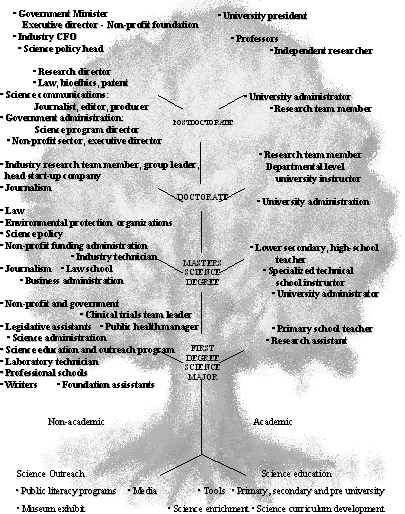
Figure 1-2-58 Diverse career paths for science and technology workers
Source:
"Conference on International Training and Support
of Young Researchers in Natural Science" November 2001, Strasbourg, France
For example, there is a need for the personnel to support the creation of innovation, including the human resources with the understanding of both technology and business to realize the market value of the research and development, as well as the personnel to strategically adopt and utilize the intellectual assets resulting from science and technology, in addition to the engineers to commercialize the products using the new knowledge. Furthermore, as mentioned in 1, there is a need for such people as "S&T communicators" who form a bridge between S&T and society by explaining science and technology to the public in an easy-to understand manner and providing feedback to the researchers and engineers on the opinions of the public. In fact researchers in industry, academia and government have indicated that there seems to be a strong lack of this kind of personnel (Figure 1-2-59).
Estimations also suggest that the supply of researchers and engineers may be inadequate depending of changes in economic growth and industrial structure in the future (Figure 1-2-60). According to these estimations, the number of researchers and engineers needed for real GDP growth of 2% per capita working population (equivalent to real growth of 1.2% annually of total GDP) (high level demand estimate), could be a shortage of about 160,000 researchers and 1,090,000 engineers in 20- 30, even if the current increasing trend in the number of people obtaining advanced technology degrees continues (high supply estimate).
With an aging population with fewer children, it is predicted that the labor population will decline. This means it is necessary to ensure the quantity and quality of a wide range of personnel, and to create the environments in which every person working in science and technology can exercise their abilities to the fullest.
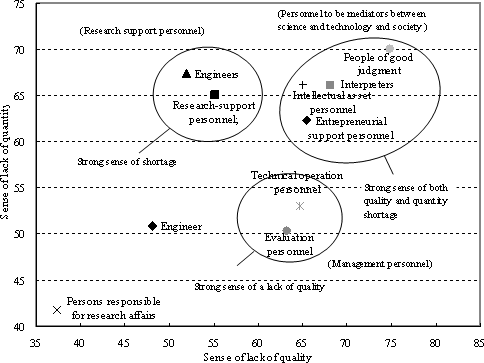
Figure 1-2-59 Lack of various personnel related to science and technology
Note:
The "sense of lack" is the percentage of researchers
who feel that there is a shortage of the corresponding personnel.
Source:
Ministry of Education, Culture, Sports, Science and Technology
"Survey of the State of Japan's Research Activities" (2005)
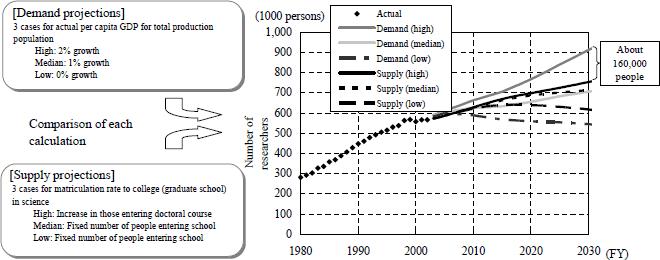
Figure 1-2-60 Projected future supply and demand of research personnel
Source:
Ministry of Education, Culture, Sports, Science and Technology
"Report on Research Personnel Future Supply and Demand" (March 2005)
● Personnel development efforts of universities/graduate schools to meet the needs of society
To work toward fostering and securing science and technology personnel, it is necessary for universities and graduate schools to continue to develop the human resources to meet the diverse demands of society, making full use of their role as a direct provider of science and technology personnel to society. This must proceed along with measures to expand the individuality and abilities of talented children, and measures to broaden the base of interest in science and technology among children in the primary and secondary stages of education.
With regard to those obtaining doctoral degrees, it is necessary to provide opportunities to be active in a broad range of society, including private business, and not limit them to career paths in academia. To achieve this, there must be development of means to teach and develop the required abilities at graduate schools.
From a quantitative perspective, in recent years although there has been a decrease in the number of students entering into the fields of science and engineering, the percentage relative to the population of 18 year-olds have been increasing, with large increases in health related fields, and a fairly steady level maintained for natural sciences (physical sciences, engineering, agriculture, health) as a whole. In addition, the absolute number of people graduating with doctoral degrees specializing in natural science fields is increasing, with a large increase in the percentage of the 27 year old population (Figure 1-2-61). A similar situation exists in the number of people graduating with masters degrees.
The evaluation of young researchers by currently-active researchers indicates high marks for knowledge of special fields, basic knowledge and cooperation, but low assessments for task setting abilities, social common sense and creativity (Figure 1-2-62). From the industrial world as well, there have been requests to the universities and graduate schools that supply the personnel, including "Teach them to think rather than giving them knowledge," "Switch from entrance exams that asses the quantity of knowledge to a format that assesses multiple facets, like the ability to think, interest, and aptitudes." (Note 17)
Based on this, it is necessary for universities and graduate schools to improve educational content and methods. In particular, for graduate schools, it is necessary to clarify the purpose of the curricula, incorporating the needs of society, and to create systematic educational programs and thoroughly manage the degree-conferment process. In the reforming of graduate school education, it is necessary to make comprehensive efforts, including the creation of world's leading centers of excellence, the establishment of graduate school evaluation and the improvement of the financial base. The Ministry of Education, Culture, Sports, Science and Technology will formulate a systematic and intensive action plan (a platform for the promotion of graduate school education for the next five years) and will implement measures based on the plan.
In addition, under the Third Basic Science and Technology Plan, along with the drastic enhancement of the quality of graduate school education, it is also planned to enhance the human resources development function of universities, including expansion of the support systems to enable talented people to continue on to earn an advanced degree without worrying about the financial burden.
Note 17:
Ministry of Education, Culture, Sports, Science and Technology
"Survey on Private Sector Research Activities" (FY2004)
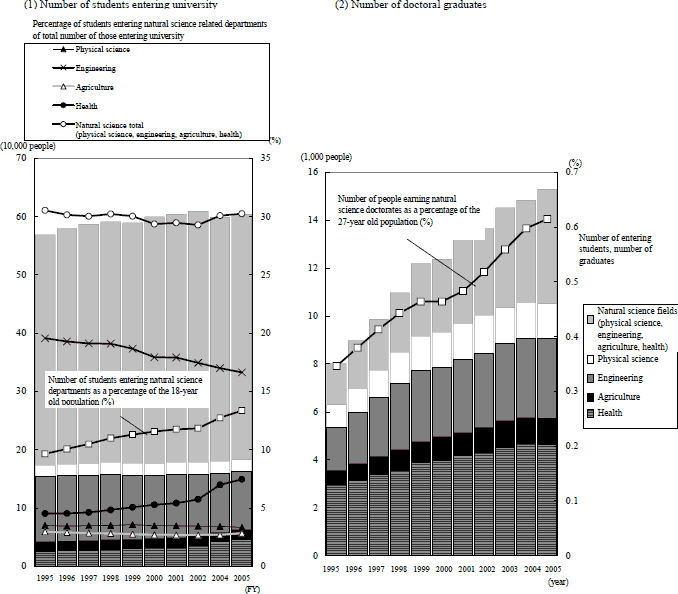
Figure 1-2-61 Number of students entering university departments and numbers of graduates from graduate schools
Notes 1:
The number of students entering university departments
only includes those enrolled on May 1 of each year
Notes 2:
The number of people graduating with doctoral degrees
is the number of graduates in March of each year
Notes 3:
The 18-year old population is calculated as the intermediate
value between the 18-year old population as of October 1 in the current year
and that as of October 1 of the immediately previous year (for 2005, the intermediate
value between the 18-year of population as of October 1, 2004 and that of October
1, 2005). The same type of calculation is made to determine the 27-year old
population.
Source:
Ministry of Education, Culture, Sports, Science and Technology
"School Basic Survey", Ministry of Internal Affairs and Communication,
Statistics Bureau "Population Statistics of Japan"
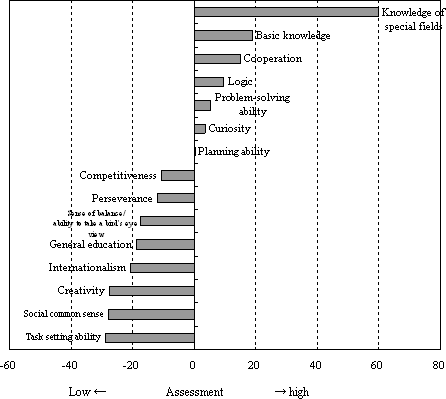
Figure 1-2-62 Evaluation of young researchers
Notes 1:
Results of a questionnaire survey of researchers in industry,
academia and government
Notes 2:
For each item, the percentage (%) of those responding
"very high" was multiplied by 2, the percentage of those responding
"high"was multiplied by 1, the percentage of those responding "low"was
multiplied by -1, and the percentage of those responding "very low"was
multiplied by -2, and the values were added together.
Source: Ministry of Education, Culture, Sports, Science and Technology "Survey
of the State of Japan’s Research Activities"(2005)
● Promotion of provision of opportunities for re-education
From the perspective of effectively utilizing a limited number of workers in an aging society with fewer children, even for people who have completed a university degree and entered into society, it is desirable for them to return to school to learn the latest theories and technologies in their specialty, to learn about new, related fields, as required, and to acquire new abilities in addition to those already acquired through their career.
For this reason, for example, it is important to develop appropriate learning opportunities, based on each individual’s choice, including engineers currently working in private business, the elderly and women who have interrupted their careers to have children or provide home care to relatives.
In recent years, while the number of working adults studying at universities and graduate schools has been increasing (Figure 1-2-63), it is desirable for universities and graduate schools to more actively provide opportunities for re-education to meet the needs of society.
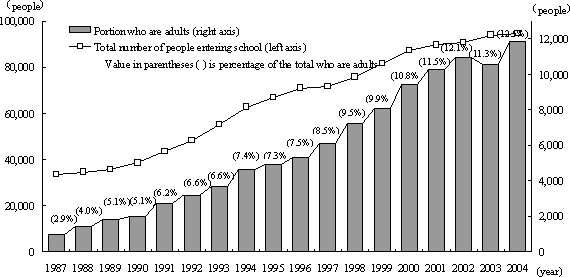
Figure 1-2-63 Trends in number of adults entering graduate school
Source:
Ministry of Education, Culture, Sports, Science and Technology
(2) Preparing an environment in which it is possible for a diverse range of personnel to be fully active
● Necessity to prepare the environment to fully utilize all personnel
In the future, even with a diversification of the venues of activity for people working in science and technology, and promotion of the development of the corresponding personnel, with the predicted decline in population and continuing aging of society with fewer children, it is likely that it will be difficult to secure the required number of workers. Accordingly, to promote an assured supply of science and technology workers, it is necessary to also prepare the environment to enable the talented existing personnel to fully utilize their skills and talents. Therefore, it is expected that the aging of society and decline in the number of children will progress. In such circumstances, it is also necessary to prepare the environments that enable talented science and technology-related personnel to fully exercise their skills, along with the effort to secure the personnel. Below is a description of steps taken to prepare the environment to enable the active participation of a wide range of people, irrespective of age, sex or nationality.
● Young researchers
Observation of the ages of Nobel Prize winners at the time they published the theory leading to their award indicates that, although there are certainly differences between individuals, highly-creative research results often seem to be produced between the ages of about 30 and 45. There is increasing concern about the supply of personnel, particularly young researchers, from a quantitative perspective as the number of children in society declines. It is more important than ever to promote the activity of talented, highly-creative young researchers.
To achieve this, it is necessary to develop the environment, such as tenure track systems, and to provide the opportunities to allow young researchers to conduct autonomous research activities and make full use of their talents. The Third Science and Technology Basic Plan also comprises government support for universities engaged in such steps to improve the environment (including providing start-up funds, improving the research support system and securing research space).
In addition, with regard to securing research funds, the Ministry of Education, Culture, Sports, Science and Technology conducted a survey of researchers on the annual total of research funds that could be allocated at their own discretion. Among researchers under the age of 35, 35% responded that there were no such research funds, and more than 60%, including the first group, indicated that the amount was less than 1 million yen. The amounts required for research differ according to the field, but for researchers between the ages of 45 and 65 the percentages are around 20%, indicating that it is currently difficult for young researchers to obtain the research funding needed to conduct their own research (Figure 1-2-64).
In light of this, the 3rd Science and Technology Basic Plan aims to increase the distribution of research funds to younger researchers, including an increased focus on support for young researchers in the competitive funding system.
Furthermore, as a result of revisions to the School Education Law in 2005, there has been a change from the previous ambiguous designation of “assistant” in the teaching staff organization at universities, with the definition of a new position of “jo-kyo” or “assistant professor” for those who primarily conduct their own teaching and research activities, and an “assistant” becoming someone who helps with teaching and research duties. (Figure 1-2-65) From the perspective of encouraging the activity of young researchers, it is hoped that universities will continue to actively hire assistant professors and to prepare arenas of activity as part of this new teaching staff organization.
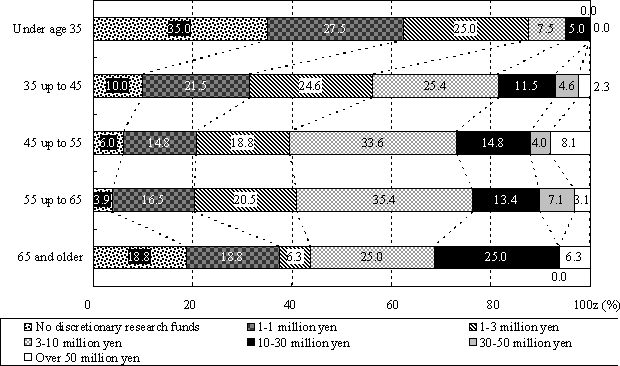
Figure 1-2-64 Annual total research funds that can be used and/or allocated at your discretion (by age)
Note:
Results of a survey of researchers at universities and public
research institutes
Source:
Ministry of Education, Culture, Sports, Science and Technology
“Survey of the State of Japan’s Research Activities” (FY2004)
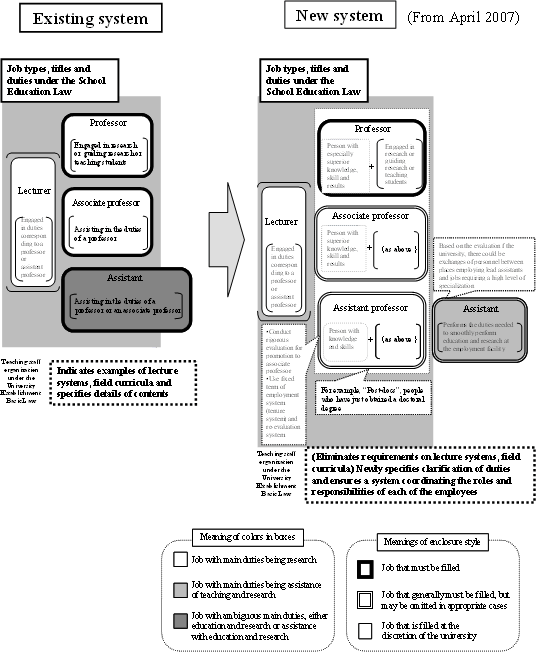
Figure 1-2-65 New university teaching staff organization system (summary)
Source:
Ministry of Education, Culture, Sports, Science and Technology
● Elderly researchers
Providing opportunities for talented people to be active, regardless of age, are important for society, also from the viewpoint of using the potential science and technology-related human resources in the higher age groups as well as young groups that are expected to increase in the future.
There is a need for universities to make it possible for talented researchers to continue their research in some form, through the use of external funding, etc., as in the USA.
In positions other than researcher as well, it is desirable to increase the opportunities for elderly personnel with a wealth of accumulated knowledge and experience to be active and productive in order to promote science and technology. For example, the activity other than research that would be of interest most commonly selected by the researchers themselves was the planning and management of research and development. In particular researchers aged 55 and older, in comparison to younger researchers, had a strong interest in managing the transfer of research results to the application destinations, evaluating research and development, and acting as interpreters between researchers and the general public (Figure 1-2-66).
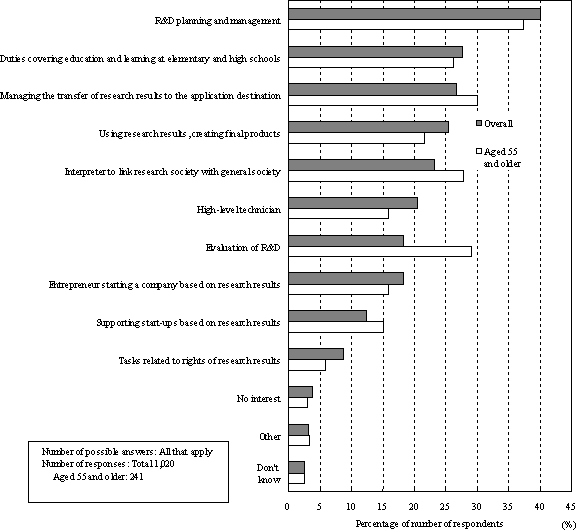
Figure 1-2-66 Jobs of interest other than research
Source:
Ministry of Education, Culture, Sports, Science and Technology
“Survey of the State of Japan’s Research Activities” (2005)
● Female researchers
With regard to females, the percentage of researchers in Japan who are female is the lowest level internationally, so there is room for them to conduct more activity. It is an urgent task to take advantage of the talents of female researchers and engineers, in order to promote gender-equality as well as to expand the pool to secure quality science and technology personnel in the future (Figure 1-2-67).
The current barriers facing women choosing a career as a researcher can be considered from two perspectives; those related to employment and promotion, and those related to the specific field.
The barriers to promotion have been called vertical sex segregation. For example, looking at the career path in a university teaching staff, from the time of entry into a university department, through the progression to graduate school, promotion to assistant, assistant professor, and to professor, the percentage of women drops at each stage of the career path.
Figure 1-2-68 shows the commonalities with other countries in Europe, although there are differences in the degree. Due to the shape, this is called a “scissors diagram”. More than in Europe, in the career overall, there are few women employed or promoted, and even at the time of entrance to the university level there is a big drop in the percentage of women in comparison to men. In addition to measures to promote the active employment and promotion of female researchers, this suggests that it is also necessary to implement some measures at the stage the females graduate from upper secondary school.
The barriers related to field are called horizontal sex segregation, and is illustrated by the concentrations of female researchers in specific fields. In Japan, in healthcare, agriculture and physical sciences, the percentage of females is comparatively higher in biology-related fields, and lower in physics and engineering (Figure 1-2-69). Meanwhile, Figure 1-2-70 shows the degree of difference between males and females in these specialized fields using an index, and makes an international comparison. This shows that the differences between men and women are larger in Japan than in other countries in Europe.
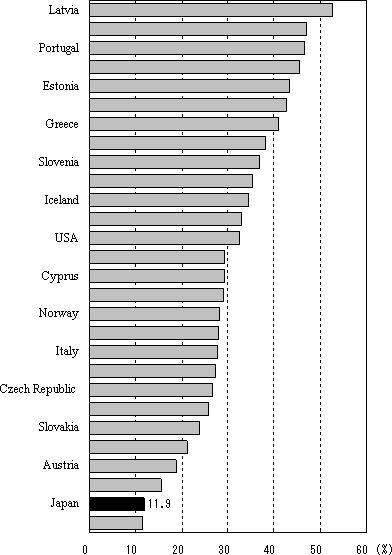
Figure 1-2-67 Percentage of female researchers (international comparison)
Source:
European Commission “Key Figures 2003 -2004”, Ministry
of Internal Affairs and Communication, Statistics Bureau “Report on the Survey
of Research and Development” (2005), OECD “Main Science and Technology Indicators”
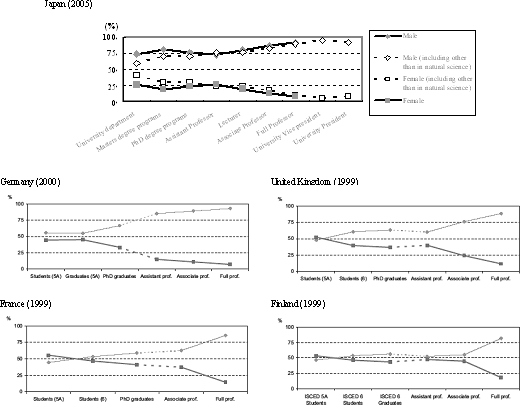
Figure 1-2-68 Percentages of males and females among students and faculty in natural science fields at universities (International comparison)
Source:
Data for Japan, Ministry of Education, Culture, Sports,
Science and Technology “School Basic Survey 2005” Other countries, European
Commission “National Policies on Women and Science in Europe”
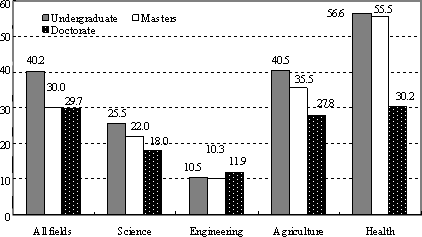
Figure 1-2-69 Percentage of female students by major in Japanese universities
Source:
Ministry of Education, Culture, Sports, Science and Technology
“School Basic Survey 2005”
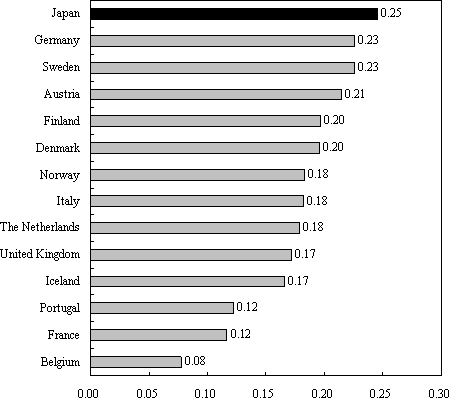
Figure 1-2-70 Difference between males and females in specialty fields (international comparison)
Note:
Calculated using the following formula using the number of
researchers in the higher education sector in each country
Dissimilarity
Index=0.5*∑|(Fi/F)-(Mi/M)|
i:Field (physics,
engineering, agriculture, health, social science, humanities, and others)
Fi:number
of female researchers in field i, F: Total number of female researchers in all
fields
Mi:number of male researchers in field i, M: Total number of male
researchers in all fields
Source:
For Japan, Statistics Bureau “Report on the Survey of
Research and Development” (2005)
For other countries, European Commission
“She Figures 2003”
As this shows, not only is the percentage of female researchers in Japan low, there is also a big gap in promotion and in fields of specialization between men and women. A questionnaire was conducted on researchers to ask the reasons for the small number of females. Most respondents indicated family circumstances, such as child birth, child care and home care for relatives. It is thought to be difficult to handle both this kind of family responsibility and the responsibilities of research work. The answers from female researchers indicate that many feel that females are at a disadvantage regarding evaluations, promotions and assignments (Figure 1-2-71).
As a result, a variety of measures will be implemented to promote the activity of female researchers through the Third Science and Technology Basic Plan.
First, with regard to the granting of competitive funding, there should be expansion of measures that consider the balancing of conducting research and childbirth/child-rearing, etc., such as allowing for term extensions and interruptions for fixed periods for the purpose of childbirth and child-rearing.
Furthermore, universities and public research institutions are required to implement not only steps to improve the environment but also activities including awareness-raising by supporting the balance between research and child birth/rearing in the action plans to be formulated and implemented based on the Law for Measures to Support the Development of the Next Generation. The Government will provide support for research institutions implementing efforts that others should follow. It is also expected to actively recruit females in terms of hiring, promotion and participation in policy bodies through the setting of a numerical target for the recruitment of female researchers at each institution. (The prospective recruitment target for female researchers in the natural science field is 25%.)
In addition, since there is already a large drop in the percentage of females that continue their education at the university level, there will also be efforts to increase interest and curiosity in young female students and children.
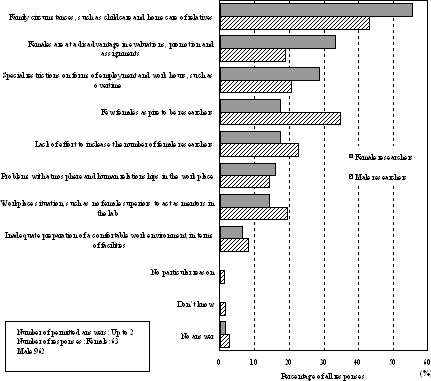
Figure 1-2-71 Reasons there are few female researchers
Source:
Ministry of Education, Culture, Sports, Science and Technology
“Survey of the State of Japan’s Research Activities” (2005)
● Foreign researchers
In the midst of promotion of the active participation of a diverse range of personnel, it is important to prepare the environment that allows talented researchers from other countries to live and work in Japan, from the perspective of not only securing personnel, but also improving the level and internationalization of research activity in Japan.
However, the percentage of foreigners in general among highly-skilled workers is extremely low in Japan relative to international levels (Figure 1-2-72). Among researchers, there are only about 11,000 foreigners(Notes 18), accounting for only 1.4% of the total number of researchers in Japan.
Note 18:
Total of those with residence visas for “professor”
and “research” according to the Ministry of Justice “Resident Foreigner Statistics”
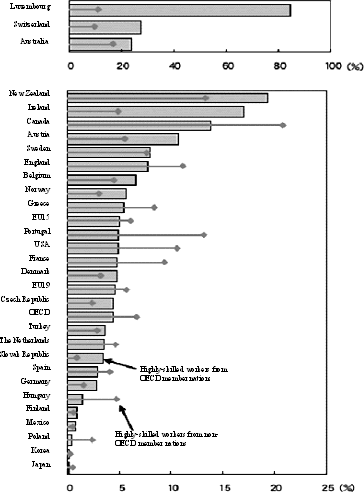
Figure 1-2-72 Percentage of foreigners among highly-skilled workers (international comparison)
Note:
A “highly-skilled worker” hear means someone with advanced
education
Source:
OECD “Science, Technology and Industry Scoreboard, 2005”
According to the results of a survey of researchers in Japan, the most common reason for the small number of foreign researchers in Japan is “problems with communication, such as language”. Other common reasons include “poor research environment in Japan (research funding, research support system)”, “there are few foreign researchers who want to do research in Japan”, and “troublesome process to hire foreign researchers, such as obtaining work visas, etc” (Figure 1-2-73).
The acquisition of talented researchers is currently the focus of fierce international competition among the USA, China and countries in Europe. In order to encourage universities and public research institutes to invite and recruit talented foreign researchers, the government of Japan will support the establishment of preparedness to accept them, that not only pays attention to the quality of research environments, but also to housing and schools for their children. Additionally, the government will further promote necessary reviews and operational improvements of the immigration control system and visa systems.
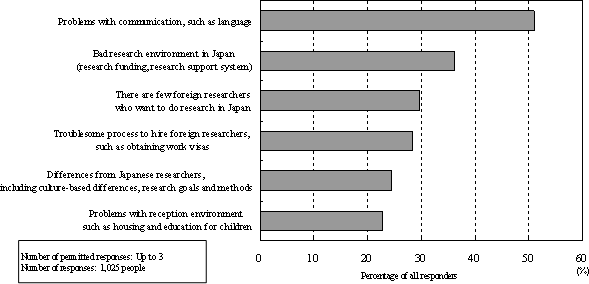
Figure 1-2-73 Reasons for small number of foreign researchers (top 6 reasons)
Source:
Ministry of Education, Culture, Sports, Science and Technology
“Survey of the State of Japan’s Research Activities” (2005)
Contacts
Research and Coordination Division, Science and Technology Policy Bureau
(Research and Coordination Division, Science and Technology Policy Bureau)




